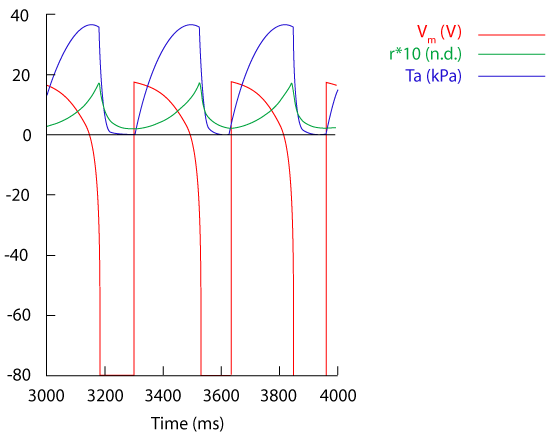Nash, Panfilov, 2004
Model Status
This is the original unchecked version of the model imported from the previous CellML model repository, 24-Jan-2006.
Model Structure
Sudden cardiac death is the leading cause of premature death in the developed world. Underlying these potentially lethal cardiac arrhythmias are reentrant electrical sources, or rotating spiral waves of excitation, and it has been shown that each class of cardiac arrhythmia is associated with a particular type of spiral wave. Sudden cardiac death during ventricular fibrillation results in a compromised mechanical pump function of the heart. Disrupted patterns of electrical excitation during ventricular fibrillation results in desynchronised cardiac contractions.
Mathematical modelling is a useful technique for investigating the electrical activity of the heart. Over the past 40 years models have also been used to study the spatio-temporal dynamics of reentrant arrhythmias in 2D, 3D, and in anatomically accurate geometric models of the heart. The mathematical models are based on physiological data, and in parallel with the increasing sophistication of experimental techniques, the mathematical models has also evolved in their complexity and biological accuracy. Previously, mathematical models have tended to focus on either the electrical properties of the heart, or on cardiac mechanics. In the study described here, Nash and Panfilov establish a mathematical model which combines the effects of cardiac mechanics and electrical activity during arrhythmia.
The model described here in CellML is based on the Nash and Panfilov 2004 paper, which describes an electromechanical model of excitable tissue, which is used to study reentrant cardiac arrhythmias. This mathematical model is a version of the modified FitzHugh-Nagumo model, published by Aliev and Panfilov in 1996 (for details on the original model please see The FitzHugh-Nagumo Model, 1961). While the original two-variable model described a non-dimensional activation variable (u) and a non-dimensional recovery variable (v), here Nash and Panfilov formulate the model in terms of the real action potential given by the time course of the transmembrane potential (Vm). In so doing, the time rate of change of the activation variable describes the total ionic current through the membrane with the original model parameters adjusted to give the correct dimensionality. This 1996 version of the FitzHugh-Nagumo model has been further modified by Nash and Panfilov in this 2004 study to include the simplest model of active tension development.
The main equations in the paper are Eqn 22abc and Eqn 23. When the first author of this paper converted the model into CellML, he noticed two main errors in the original paper:
-
Eqn 22b: b should be a, and
-
Eqn 23: the factor 10 should be on first case line (V is less than 0.05). The second case should have the factor 1.
A new set of model parameters is also used.
The complete original paper reference is cited below:
Electromechanical model of excitable tissue to study reentrant cardiac arrhythmias, M. P. Nash and A. V. Panfilov, 2004, Progress in Biophysics and Molecular Biology , 85, 501-522. (Full text (HTML) and PDF versions of the article are available to subscribers on the Progress in Biophysics and Molecular Biology website.) PubMed ID: 15142759
 |
| Properties of the action potential described by the model. |

